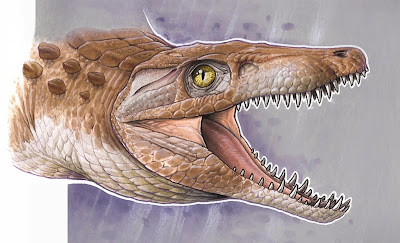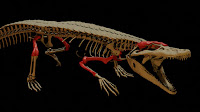 |
| Burkesuchus mallingrandensis Novas, Agnolin, Lio, Rozadilla, Suárez, de la Cruz, de Souza Carvalho, Rubilar-Rogers & Isasi, 2021 Illustration: Gabriel L. Lio |
Abstract
We describe the basal mesoeucrocodylian Burkesuchus mallingrandensis nov. gen. et sp., from the Upper Jurassic (Tithonian) Toqui Formation of southern Chile. The new taxon constitutes one of the few records of non-pelagic Jurassic crocodyliforms for the entire South American continent. Burkesuchus was found on the same levels that yielded titanosauriform and diplodocoid sauropods and the herbivore theropod Chilesaurus diegosuarezi, thus expanding the taxonomic composition of currently poorly known Jurassic reptilian faunas from Patagonia. Burkesuchus was a small-sized crocodyliform (estimated length 70 cm), with a cranium that is dorsoventrally depressed and transversely wide posteriorly and distinguished by a posteroventrally flexed wing-like squamosal. A well-defined longitudinal groove runs along the lateral edge of the postorbital and squamosal, indicative of a anteroposteriorly extensive upper earlid. Phylogenetic analysis supports Burkesuchus as a basal member of Mesoeucrocodylia. This new discovery expands the meagre record of non-pelagic representatives of this clade for the Jurassic Period, and together with Batrachomimus, from Upper Jurassic beds of Brazil, supports the idea that South America represented a cradle for the evolution of derived crocodyliforms during the Late Jurassic.
Systematic paleontology
Archosauria Cope, 1869.
Crocodyliformes Hay, 1930.
Mesoeucrocodylia Whetstone and Whybrow, 1980.
Burkesuchus mallingrandensis nov. gen. et sp.
Diagnosis: Small-sized crocodyliform diagnosed on the following combination of characters (autapomorphies marked by an asterisk*): cranial roof bones ornamented by grooves and pits; frontals fused and subtriangular in contour, with strongly convergent lateral margins anteriorly; frontals anteroposteriorly short (transverse width representing approximately 90% of its length)*; squamosal posteroventrally flexed forming a wide bony wing and delimiting the posterior opening of the meatal chamber, which is reduced to a small duct*; supratemporal foramen small; squamosal and quadrate widely exposed on occipital surface of cranium; paraoccipital processes of otoccipital relatively small; foramina for cranial nerves IX-XII dorsally limited by the paraoccipital process; and dorsal vertebrae with kidney-shaped prezygapophyses.
Etymology: Genus name honours Mr. Coleman Burke (New York, USA), who generously supported the field exploration in which the fossils were discovered; and suchus, from Latin, crocodile; species name mallingrandensis, refers to Mallín Grande, a beautiful region in southern Chile adjacent to the fossil locality.
Locality and horizon: The holotype and referred specimens of Burkesuchus were collected from beds of the Toqui Formation, cropping out in the mountains flanked by the Maitenes and Horquetas rivers, south of General Carrera Lake (Fig. 1). The rock succession consists of a 300–320 m thick sequence of conglomerates with intercalated tuffs. Burkesuchus fossils occur in an approximately 100 m succession of alternating green volcaniclastic pebbly sandstones and sandy sedimentary breccias, with intercalations of lapilli tuffs and red ignimbrites with eroded tops. The U-Pb SHRIMP age of 147 ± 1.0 Ma was obtained from zircon samples from the ignimbrite that immediately underlies the fossil-bearing levels, indicating a Tithonian age (latest Jurassic) for Burkesuchus and its associated fauna. Other fossil vertebrates currently documented from these beds include titanosauriform and diplodocoid sauropods, along with the herbivorous theropod Chilesaurus diegosuarezi.
 |
| Locality map, geological context, and skeletal reconstruction of Burkesuchus mallingrandensis. Skeletal reconstruction based on holotype and paratype specimens. |
Fernando E. Novas, Federico L. Agnolin, Gabriel L. Lio, Sebastián Rozadilla, Manuel Suárez, Rita de la Cruz, Ismar de Souza Carvalho, David Rubilar-Rogers and Marcelo P. Isasi. 2021. New Transitional Fossil from late Jurassic of Chile sheds light on the Origin of Modern Crocodiles. Scientific Reports. 11: 14960. DOI: 10.1038/s41598-021-93994-z











